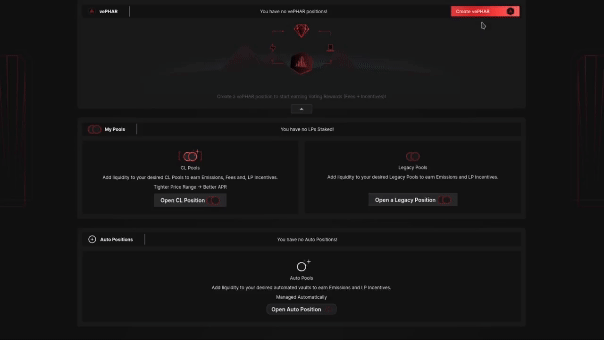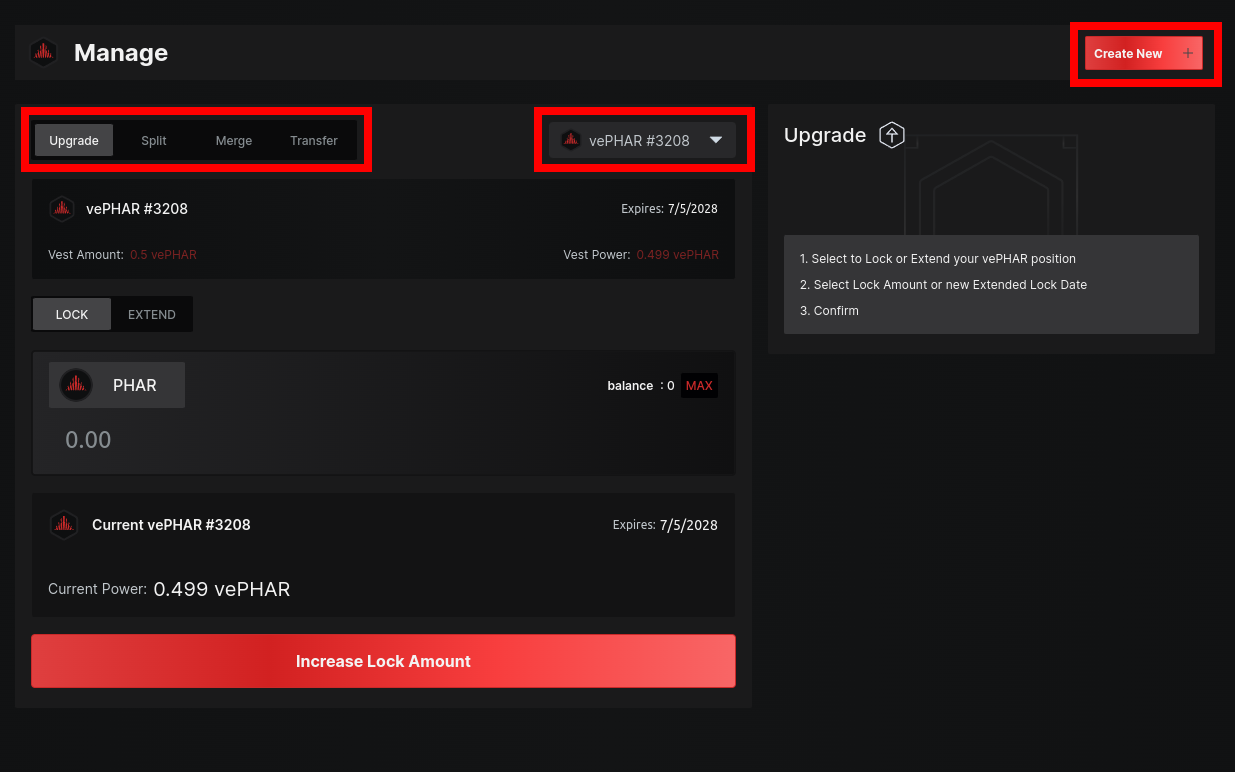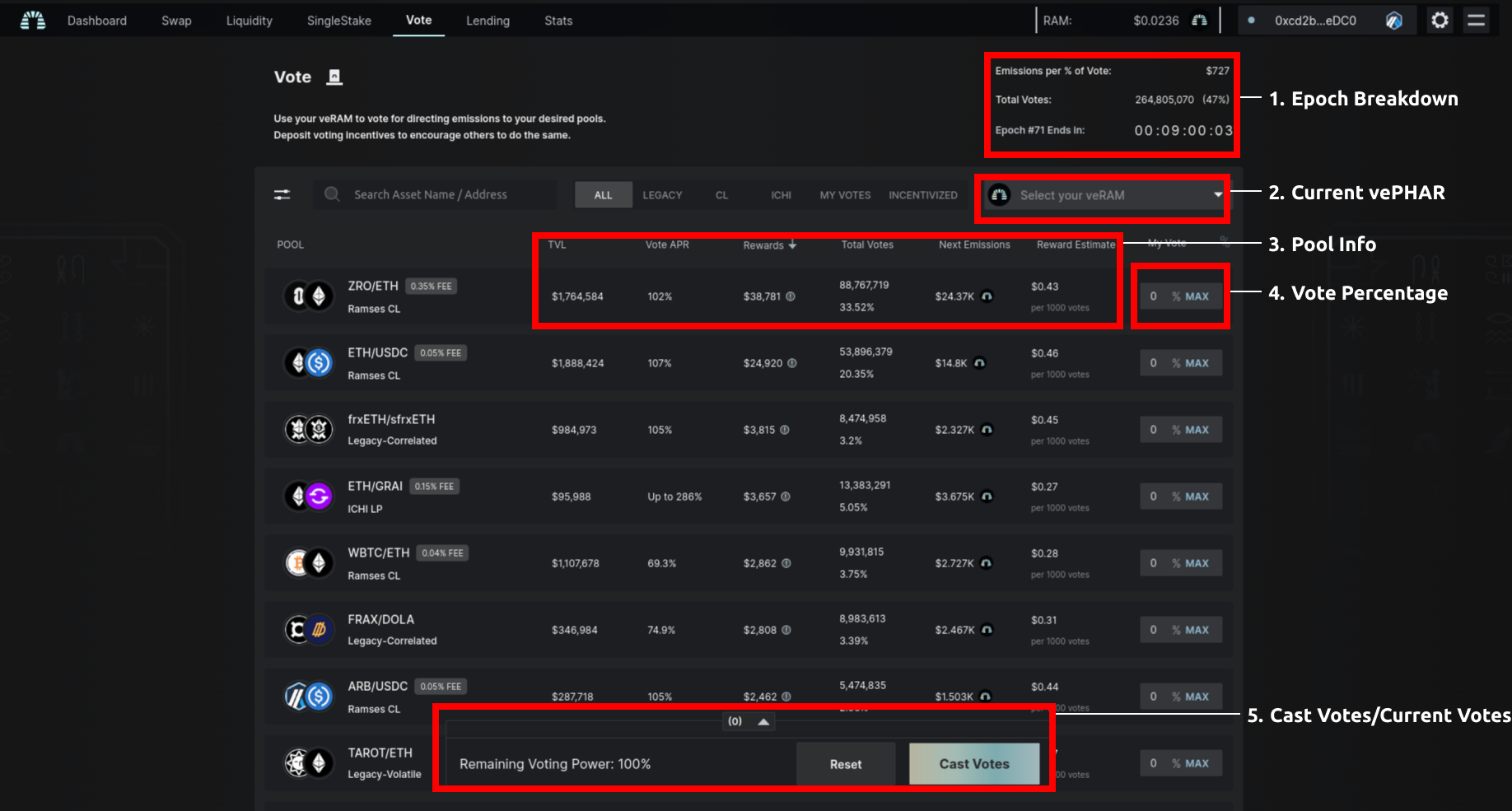Guides
How To Vote
How to use the Ramses DEX to vote every Epoch!
Before You Vote!
Voting on Ramses is a governance process mainly used to change the tides of token emissions week over week to point emissions where they matter. It is in a voter's best interest to vote for high performing pairs in fees & incentives as they will earn fees for their voted pairs. In doing so the system designates RAM to these pairs causing a higher influx of users to provide liquidity which results in more fees to that pair.
Definition
Epoch: A unit of geologic time that is a division of a period. We use the term epoch as a indicator when all votes and rewards are reset for the following week, starting a fresh week of new incentives.
For Ramses this period of time is 7 days always restarting at 00:00 Thursday UTC time.
Quick Notes
Below are some quick notes to keep in mind when starting your voting process:
- xRAM is the token used to cast votes each week. It is represented by an ERC-721 (NFT) token that has the accounting of the burnt RAM in the contract.
- RAM can be burnt to generate xRAM at anytime.
- xRAM is completely irreversible, a user cannot convert back to RAM once they make the decision to go burn for xRAM.
- A user can change their vote anytime during the current epoch and often times many will wait until the very last minutes to maximize potential returns.
- Once selecting a vote and the epoch rolls over, any incentives collected will be distributed to those voters. The following epoch will start streaming these fees for that pair back to the voters as well.
- APR's displayed on the Vote page are only a estimate from the previous 7 days of performance NOT what you will receive on EPOCH roll over. This is to accurately display earning of that pair for the user to expect over the coming week.
- Votes are reset after each EPOCH so a user must select a pair for each current epoch.
Creating xRAM
 Creating xRAM can be done on the Dashboard page. Clicking the top right "Create xRAM" button you will be prompted with a modal allowing a new position to be minted.
Creating xRAM can be done on the Dashboard page. Clicking the top right "Create xRAM" button you will be prompted with a modal allowing a new position to be minted.
Select the amount of RAM, and burn it for your new xRAM position, or to add to an existing position.
Managing xRAM
Once a new position is made, your dashboard will show the newly minted xRAM with a corresponding #. By selecting the Manage button you will be moved into the veManage page.

From here you can now use the filter tab on the top left to:
- Upgrade
- Split
- Merge
- Transfer
As well as select other xRAM positions ore create new ones.
Upgrade
The upgrade module allows you to burn more RAM to add to the same xRAM position.
Split
When Split is selected, you can choose to break apart your xRAM into more xRAM positions based on percentages or amounts. This could be useful when wanting to transfer or trade a larger position into smaller ones.
Merge
Inversely, you can merge multiple xRAM positions into the same using the Merge Tab.
Transfer
Since the xRAM token is a ERC-721, users can transfer freely to other EVM compatible wallets using the Transfer tab.
Vote Page

1. Epoch Rewards
Epoch Rewards section will breakdown the current amount of emissions per percentage of vote you have in dollar value. Also you can find the current total votes cast currently between all xRAM.
Lastly you will be shown a timer of the current EPOCH timer until the next EPOCH will happen. Remember EPOCH's ALWAYS happen at 00:00 UTC on Thursday!
Definition
Most users on ve DEX's will wait until the final few minutes before EPOCH end to cast votes. This is usually due to wanting to see the dillution present on each pool and find the highest impact votes they can produce. If you are new to the process it may help to watch for this and learn the ebbs and flows of the ecosystem.
2. Current xRAM
Here you can select each xRAM position held in a wallet to ensure you can vote on each on owned.
3. Pool Info
Pool info gives the user a better look at the pools performance and possible impact on your casted vote.
- TVL is the current amount of liquidity held in the pool
- Vote APR as shown above in Quick Notes is a projected value based on the previous 7 days of fees to show a PROJECTED APR.
- Rewards are the culmination of projected fees and any added Voting Incentives by protocols or users.
- Total votes shows the current percentage of votes compared to all xRAM in existence.
- Next Emissions looks at the current percentage of votes, and the following emission schedule for RAM to show the dollar value of emitted RAM to the pool.
- Reward estimate is the assumed estimate of total rewards and fees given to you based on the percentage and amount of xRAM used to cast your vote to that pool.
4. Vote Percentage
Using xRAM, you can vote on multiple pools and designate percentages of your xRAM position to delegate to multiple pools.
5. Cast Votes/Current Votes
Ensure you select cast vote once done adding percentages and making your selected votes!
Earnings
Once votes are cast the xRAM will not start earning until the Epoch ends. Any extra vote incentives, along with earned fees, added to the pools voted will be given once the next EPOCH "rolls over."
Example
An easy example of how to estimate your individual performance on a voted pair: Ramses One votes with 1 xRAM on ETH/USDC pair, Ramses Two also votes on the same pair with one xRAM. Assuming no other votes exist on the pair and a fee performance of $100 dollars on this pair over the following week, each Ramses will earn $50 in streamed fees.